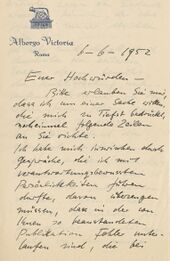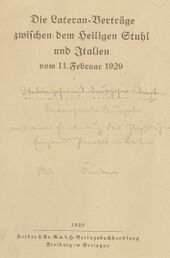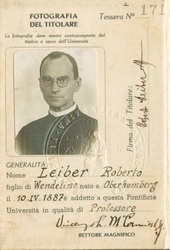Difference between revisions of "Robert Leiber Collection"
| Line 25: | Line 25: | ||
The intention of the APUG is to make the documentation of the Leiber Fund available to researchers by digitizing it, metadating it, and subsequently transcribing and annotating it.<br> | The intention of the APUG is to make the documentation of the Leiber Fund available to researchers by digitizing it, metadating it, and subsequently transcribing and annotating it.<br> | ||
===Religion and Society=== | ===Religion and Society=== | ||
| − | At first glance, it seems that the documentation was formed from the opposition of two institutional spheres: the Church and the State. This could be deduced from a text (probably a lecture note) by Leiber himself (cfr. Document | + | At first glance, it seems that the documentation was formed from the opposition of two institutional spheres: the Church and the State. This could be deduced from a text (probably a lecture note) by Leiber himself (cfr. Document RL 13; Folder III, ''Religion u. Gesellschaft. Kirche u. Staat'')<br> |
<br> | <br> | ||
The question we are interested in can be approached from three perspectives: we can approach it, that is, as a question of value - what value, what meaning, what task do religion and the Church assume for human society, within the totality of the State? But we can approach the same problem from the side of right, and then the question will sound: what is the legal quintessence of the relations - planned or existing - between State and Church? Both questions are closely connected and complement each other. Church and religion orientate their legal relationship with the state from the task they perform within society - and vice versa: depending on their legal relationship with the state, religion and church will be able to fulfill their task to a greater or lesser extent. Here we want to deal with both sides of the issue.A large portion of this documentation revolves around the theme Die Konkordatsfrafge. At a more abstract level, one could say that from these documents it is possible to observe how the relationship between religion and society was shaped. Indeed, making this relationship more intelligible with an adequate theory of society could be the task of research.>br> | The question we are interested in can be approached from three perspectives: we can approach it, that is, as a question of value - what value, what meaning, what task do religion and the Church assume for human society, within the totality of the State? But we can approach the same problem from the side of right, and then the question will sound: what is the legal quintessence of the relations - planned or existing - between State and Church? Both questions are closely connected and complement each other. Church and religion orientate their legal relationship with the state from the task they perform within society - and vice versa: depending on their legal relationship with the state, religion and church will be able to fulfill their task to a greater or lesser extent. Here we want to deal with both sides of the issue.A large portion of this documentation revolves around the theme Die Konkordatsfrafge. At a more abstract level, one could say that from these documents it is possible to observe how the relationship between religion and society was shaped. Indeed, making this relationship more intelligible with an adequate theory of society could be the task of research.>br> | ||
===Copyrights=== | ===Copyrights=== | ||
'''Unless otherwise indicated''', all files and contributions (transcriptions, pages, comments) uploaded and submitted to GATE by administrators and users are considered to be released under the [https://creativecommons.org/licenses/by-nc-nd/4.0/ '''Creative Commons Attribution-NonCommercial-NoDerivatives 4.0 International License''']. All the rights on the images of the manuscripts or other documentation are property of the Historical Archives of the Pontifical Gregorian University ([[User:ArchivesPUG]]). If you need high resolution images for your publications or for other usages, please contact us [[Special:Contact|using this form]]. [[File:Cc_by-nc-nd_euro_icon.svg|right]]<br /> | '''Unless otherwise indicated''', all files and contributions (transcriptions, pages, comments) uploaded and submitted to GATE by administrators and users are considered to be released under the [https://creativecommons.org/licenses/by-nc-nd/4.0/ '''Creative Commons Attribution-NonCommercial-NoDerivatives 4.0 International License''']. All the rights on the images of the manuscripts or other documentation are property of the Historical Archives of the Pontifical Gregorian University ([[User:ArchivesPUG]]). If you need high resolution images for your publications or for other usages, please contact us [[Special:Contact|using this form]]. [[File:Cc_by-nc-nd_euro_icon.svg|right]]<br /> | ||
| − | Your contributions to GATE must be original or, at most, copied from public domain or similar free sources. Remember to always cite your sources and, more important, '''do not submit copyrighted work without permission'''.<br | + | Your contributions to GATE must be original or, at most, copied from public domain or similar free sources. Remember to always cite your sources and, more important, '''do not submit copyrighted work without permission'''.<br> |
|-| | |-| | ||
Revision as of 13:53, 27 July 2022
| Correspondence | Works | Bibliography | |
|---|---|---|---|
Birth of the project
Since the opening of the archival fonds of the Holy See relating to the pontificate of Pius XII (1939 - 1958) on 2 March 2020, the documentation of the Jesuit Robert Leiber (1888-1967) has begun to arouse some interest.Making the entire Leiber Fund available to researchers by the Historical Archives of the Pontifical Gregorian University represents an opportunity to consider the selection that has been put in place from its creation to the archiving and later indexing stages.
This project, like the others on this platform, assumes that documentation is communicative and not a perceptual material. The document is considered here as a communicative product. Therefore, like all communication, it is subject to rules of social order, is immersed in a narrative tradition and appears under certain conventions. Its proper place of production and reception is the social system and not individual consciousness.
The researcher has no access to the latter. Precisely with a non-humanist practice of the discipline of history, a certain cognitive gain could be achieved by restoring the centrality of the document as communication, thus describing the evolution of ideas.
The intention of the APUG is to make the documentation of the Leiber Fund available to researchers by digitizing it, metadating it, and subsequently transcribing and annotating it.
Religion and Society
At first glance, it seems that the documentation was formed from the opposition of two institutional spheres: the Church and the State. This could be deduced from a text (probably a lecture note) by Leiber himself (cfr. Document RL 13; Folder III, Religion u. Gesellschaft. Kirche u. Staat)
The question we are interested in can be approached from three perspectives: we can approach it, that is, as a question of value - what value, what meaning, what task do religion and the Church assume for human society, within the totality of the State? But we can approach the same problem from the side of right, and then the question will sound: what is the legal quintessence of the relations - planned or existing - between State and Church? Both questions are closely connected and complement each other. Church and religion orientate their legal relationship with the state from the task they perform within society - and vice versa: depending on their legal relationship with the state, religion and church will be able to fulfill their task to a greater or lesser extent. Here we want to deal with both sides of the issue.A large portion of this documentation revolves around the theme Die Konkordatsfrafge. At a more abstract level, one could say that from these documents it is possible to observe how the relationship between religion and society was shaped. Indeed, making this relationship more intelligible with an adequate theory of society could be the task of research.>br>
Copyrights
Unless otherwise indicated, all files and contributions (transcriptions, pages, comments) uploaded and submitted to GATE by administrators and users are considered to be released under the Creative Commons Attribution-NonCommercial-NoDerivatives 4.0 International License. All the rights on the images of the manuscripts or other documentation are property of the Historical Archives of the Pontifical Gregorian University (User:ArchivesPUG). If you need high resolution images for your publications or for other usages, please contact us using this form.Your contributions to GATE must be original or, at most, copied from public domain or similar free sources. Remember to always cite your sources and, more important, do not submit copyrighted work without permission.
La nascita del progetto
Con motivo dell’apertura dei fondi archivistici della Santa Sede relativi al pontificato di Pio XII (1939 – 1958) avvenuta il 2 marzo 2020 la documentazione del gesuita Robert Leiber (1888-1967) ha cominciato a suscitare un certo interesse.
Per l’Archivio Storico della Pontificia Università Gregoriana mettere a disposizione dei ricercatori l’intero Fondo Leiber rappresenta una possibilità di considerare la selezione messa in essere a partire dalla sua creazione sino alle fasi di archiviazione e posteriormente indicizzazione.
Questo progetto, così come gli altri presenti in questa piattaforma, parte dal presupposto che la documentazione sia un materiale comunicativo e non percettivo. Il documento viene qui considerato come un prodotto comunicativo. Pertanto, come ogni comunicazione, è assoggettato a regole di ordine sociale, si trova immerso in una tradizione narrativa e appare sotto determinate convenzioni. Il suo luogo proprio di produzione e di ricezione è il sistema sociale e non la coscienza individuale. A questa ultima il ricercatore non ha nessuna possibilità di accesso. Precisamente con una pratica non umanista della disciplina storica potrebbe ottenersi un certo guadagno conoscitivo ridando la sua centralità al documento, in quanto comunicazione, per così descrivere l’evoluzione delle idee.
L’intenzione dell’APUG è mettere a disposizione dei ricercatori la documentazione del Fondo Leiber procedendo alla sua digitalizzazione, metadatazione, e posteriormente alla sua trascrizione e annotazione.
Religione e Società
Da una prima analisi sembra che la documentazione sia stata costituita a partire dalla contrapposizione di due ambiti istituzionali: la Chiesa e lo Stato. Questo si potrebbe desumere da un testo dello stesso Leiber (cfr. fig. 1):
La questione che ci interessa può essere affrontata da tre punti di vista: possiamo porla, cioè, come questione del valore – quale valore, quale significato, quale compito assumono la religione e la Chiesa per la società umana, all’interno della totalità dello Stato? Ma possiamo affrontare lo stesso problema dal lato del diritto, e allora la domanda suonerà: qual è la quintessenza giuridica dei rapporti – progettati o sussistenti – fra Stato e Chiesa? Entrambe le domande sono fra loro strettamente connesse e si completano a vicenda. Chiesa e religione orientano il loro rapporto giuridico con lo Stato a partire dal compito che svolgono all’interno della società – e viceversa: a seconda del loro rapporto giuridico con lo Stato, religione e Chiesa saranno in grado di assolvere al proprio compito in misura maggiore o minore. Qui vogliamo occuparci di entrambi i lati della questione.
Molta di questa documentazione ruota intorno al tema Die Konkordatsfrafge. A un livello più astratto si potrebbe dire che a partire da questi documenti è possibile osservare in quale modo sia stato costruito il rapporto tra religione e società. Potrebbe essere compito della ricerca rendere più intelligibile questa relazione con una adeguata teoria della società.
Copyrights
Unless otherwise indicated, all files and contributions (transcriptions, pages, comments) uploaded and submitted to GATE by administrators and users are considered to be released under the Creative Commons Attribution-NonCommercial-NoDerivatives 4.0 International License. All the rights on the images of the manuscripts or other documentation are property of the Historical Archives of the Pontifical Gregorian University (User:ArchivesPUG). If you need high resolution images for your publications or for other usages, please contact us using this form.Your contributions to GATE must be original or, at most, copied from public domain or similar free sources. Remember to always cite your sources and, more important, do not submit copyrighted work without permission.


